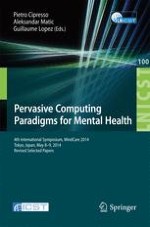2014 | Book
Pervasive Computing Paradigms for Mental Health
4th International Symposium, MindCare 2014, Tokyo, Japan, May 8-9, 2014, Revised Selected Papers
Editors: Pietro Cipresso, Aleksandar Matic, Guillaume Lopez
Publisher: Springer International Publishing
Book Series : Lecture Notes of the Institute for Computer Sciences, Social Informatics and Telecommunications Engineering
